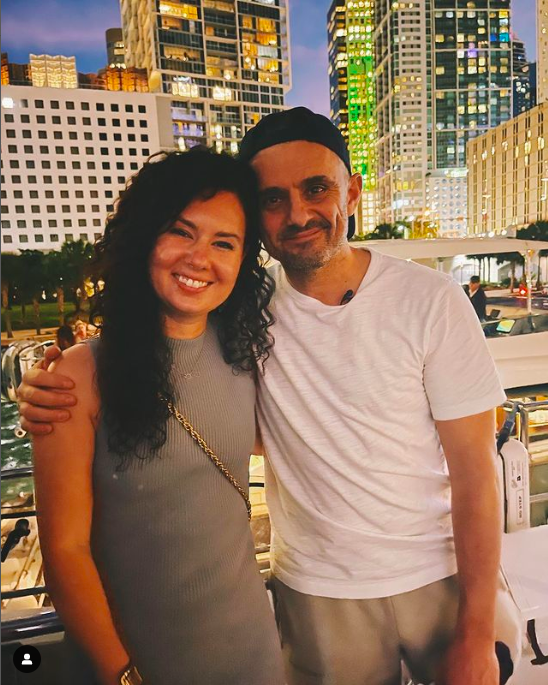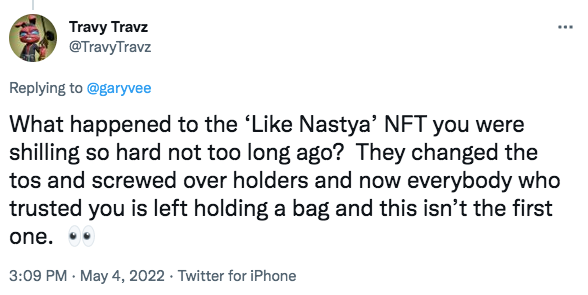Purveyor of life-altering advice including "pretend each day that one of your family has been shot in the face” and "swallow your gum instead of throwing it away (for efficiency)", Gary Vee has a huge following of devoted acolytes. When he announced that he was about to launch an NFT collection with the “biggest Youtuber in the world” Like Nastya, his followers were understandably galvanised. Vee even tweeted a supporting link to Forbes magazine, proof of the drop’s significance.

There was one problem. The link to the Forbes article didn’t go anywhere. Investors should have heeded this early red flag. The project flopped, none of its promises were fulfilled, no roadmap/future plans have been released and now Gary (along with everybody involved) behaves as though the Like Nastya NFTs never existed. You may be thinking that this sounds like a classic rug pull scenario (and you would be right) but the story is far darker than even that.
Hyping the collection
Before we delve into the depths of this story, it’s important to point out that Nastya is 8 years old. She might be one of the biggest Youtubers in the world (with 88 million subscribers on her main channel) but she isn’t controlling the trajectory of her career in any significant, business-orientated way. That’s left to her parents and Yoola (a multi channel network that manages her accounts). More on Yoola later.
After announcing the NFTs on Twitter, Vee pushed them hard, both on his personal account and on his company feed for Vaynermedia. He also posted frequently in the VeeFriends Discord, generally drumming up support and building hype across all his platforms. Vee’s followers trust him implicitly and many leapt on the project simply because their mentor was involved/recommending it.

The collection consisted of two parts. Users could collect six letters to spell Nastya’s name. These were accompanied by utilities; tokens that could be redeemed for special gifts like a phone call with Nastya or a birthday message. Anybody who collected all six letters was supposed to be airdropped a bonus seventh, but this is where the rot set in. Bitski (who hosted the NFTs) changed the terms and conditions when the collection was already live. Only people who bought the six letters at mint (not on secondary) would receive the airdrop. Traders were, understandably, furious.

The rug is pulled
The Like Nastya collection unravelled fast. After an initial pump and brief, smaller spike on secondary, sales dwindled to nearly nothing. All support for the project promptly vanished, including any plans for the future, the roadmap and the bonuses that were supposed to materialise along the way. Various gifts were promised for collectors, including toys, figurines and dolls but none of these appeared (even though a portion of proceedings were supposed to be donated to charity).

The OpenSea trading data does not present a happy picture
Even the initial launch wasn’t as successful as Vee and co probably expected. The mint generated around $127 thousand followed by $280 thousand on secondary. The numbers sound large, but they’re hardly the figures you would associate with a launch so hyped. The floor price now sits at a miserly 0.005 ETH, a slap in the face for anybody who purchased the NFTs because they believed in Gary Vee.
Strangest of all (and despite the constant early pumping from Vee), Nastya remained eerily silent. Aside from one post on her Instagram, she apparently chose not to advertise on her vast YouTube channel or post on any of her other, smaller ones (if you can call accounts with over a million followers small). Since it’s reasonable to assume that Nastya’s parents have a lot of say over what she posts, it appears as though they lost faith in the project early or always suspected that it was doomed to fail.
A sinister collective
If that seems odd, it’s worth digging deeper into the players behind this story. The trail starts with the removed Forbes article. It sold the project hard, linking it to Nastya’s big YouTube following and touting the presence of Gary Vee and Vaynermedia as sure signs of success. It also made promises about the project's future and utility, suggesting that it would be around for a long time. That article was written by Tatiana Koffman.

Note “former”
Koffman, the CEO of Yoola and Gary Vee are good friends. Pictures of them hanging out together have been shared across Instagram, giving the impression that the three people behind pumping the project are close. She is now listed as a former Forbes contributor. Although we will never know exactly why she was removed from front line duties, her article pumping a friend’s project is a massive conflict of interest. This would certainly be grounds for taking the article down and removing Koffman. Between them, Vee, Yoola and Koffman drove hype to a project which pumped and then dumped big, taking collector's money with it.

Even how the collection was marketed is dubious. The utilities are aimed at children (and rich parents), but the NFTs were sold to big collectors and investors. Of the 52 utility tokens minted, only 3 were redeemed for interactions with Nastya. This is either terrible marketing (unlikely given the personnel involved) or it’s a clue to the project’s true intentions. The aim seems to have been to pump the price as high and as fast as possible before letting the collection dwindle into oblivion. For all the promise, nothing emerged, and it looks as though it was never meant to.
This alleged rug was manipulated by a triumvirate of very powerful, very influential media figures, but at its heart, there’s a child, too young to consent to business decisions of this nature. She is now tarnished with this for the rest of her life. People still raise the spectre of Like Nastya on Vee’s tweets. Unsurprisingly, he doesn’t reply.

Read more:
How did Two Rug Pullers end up Facing Jail Time?
Was a Serial Rugging Gang Just Caught in The Act?
Cronje and Nell Leave Investors Feeling RUGGED


